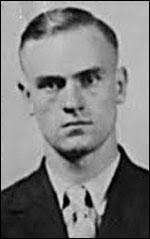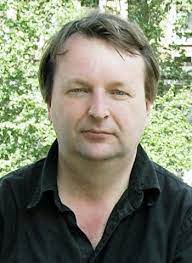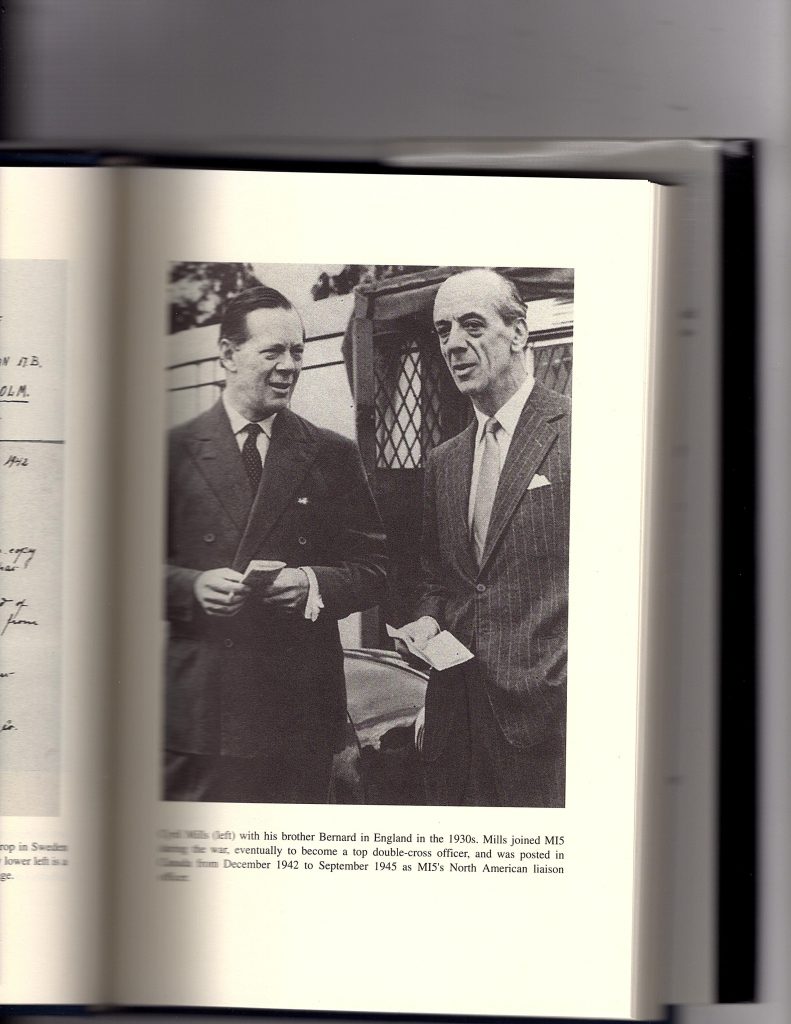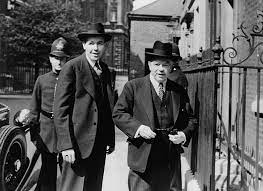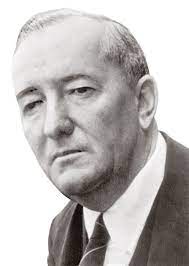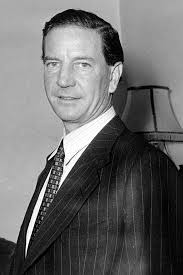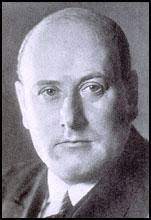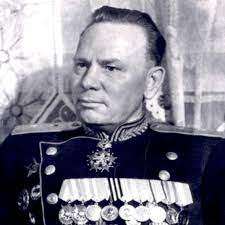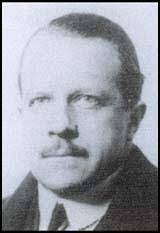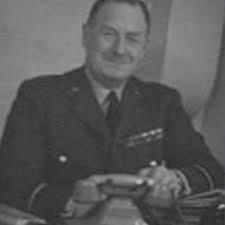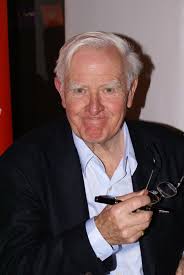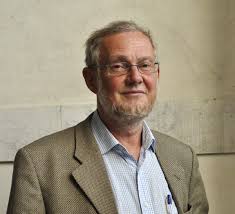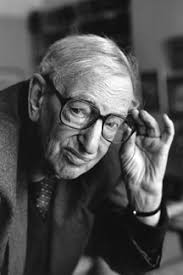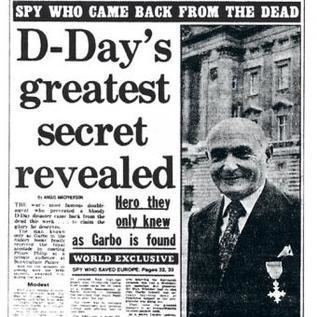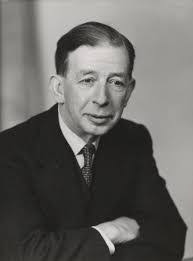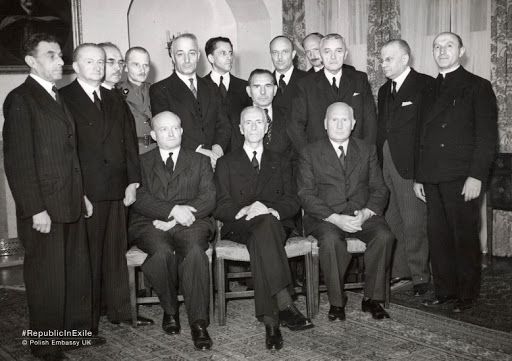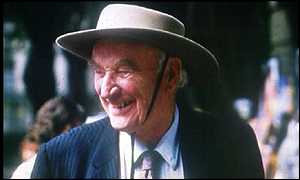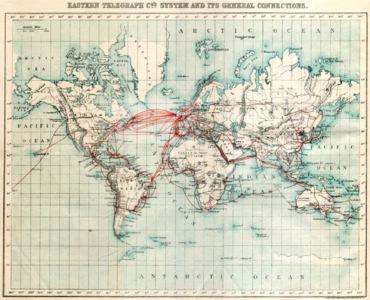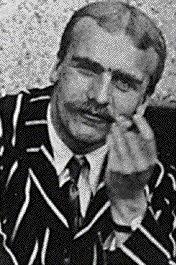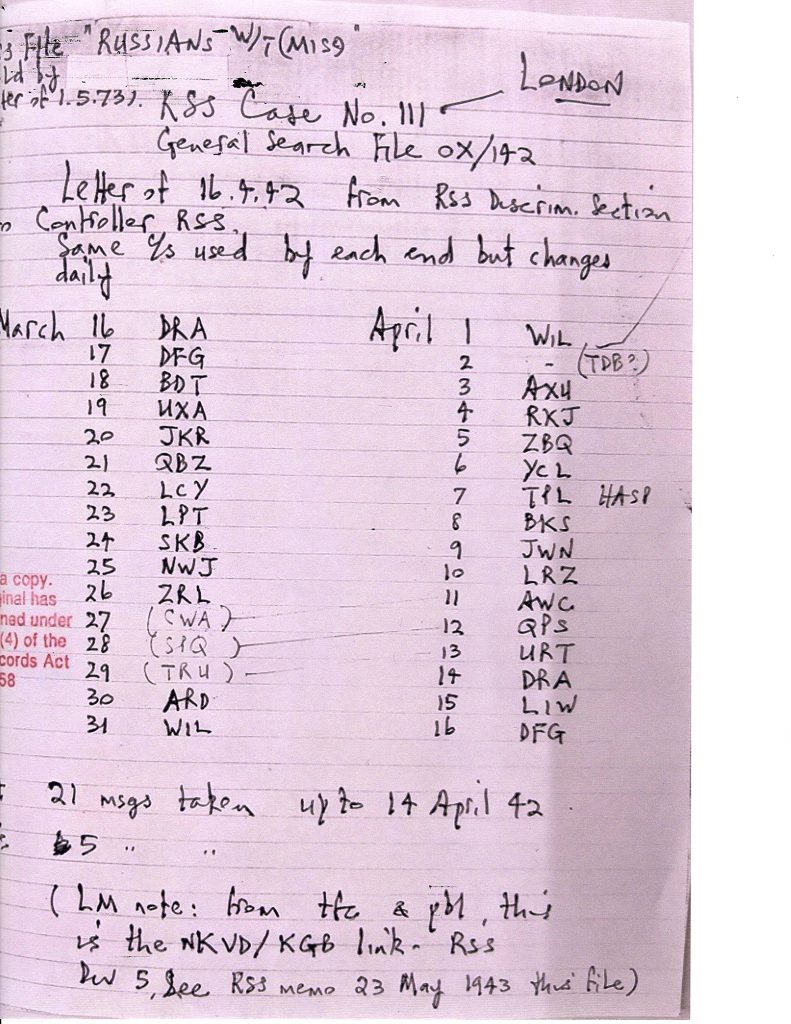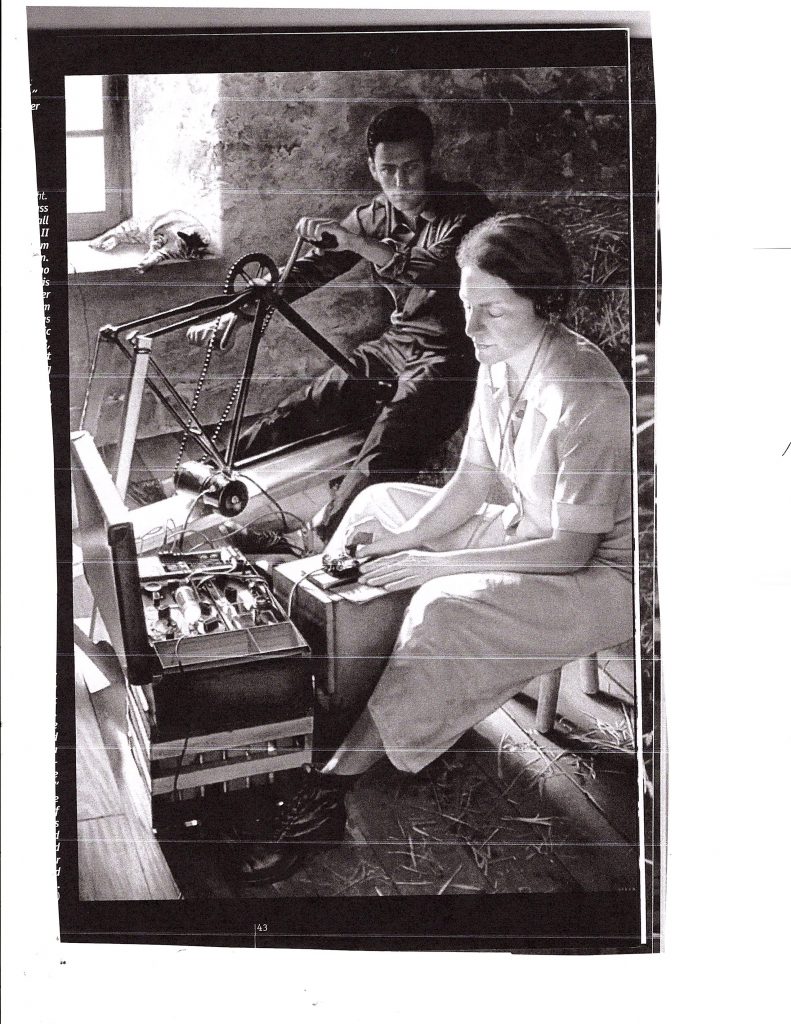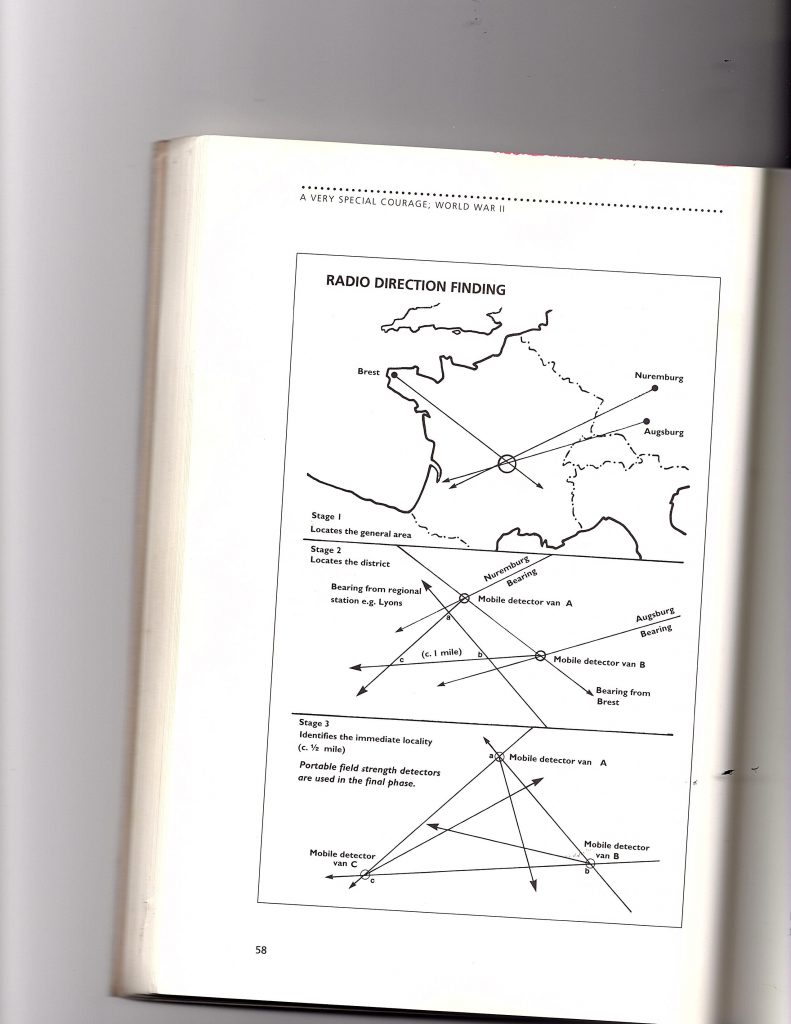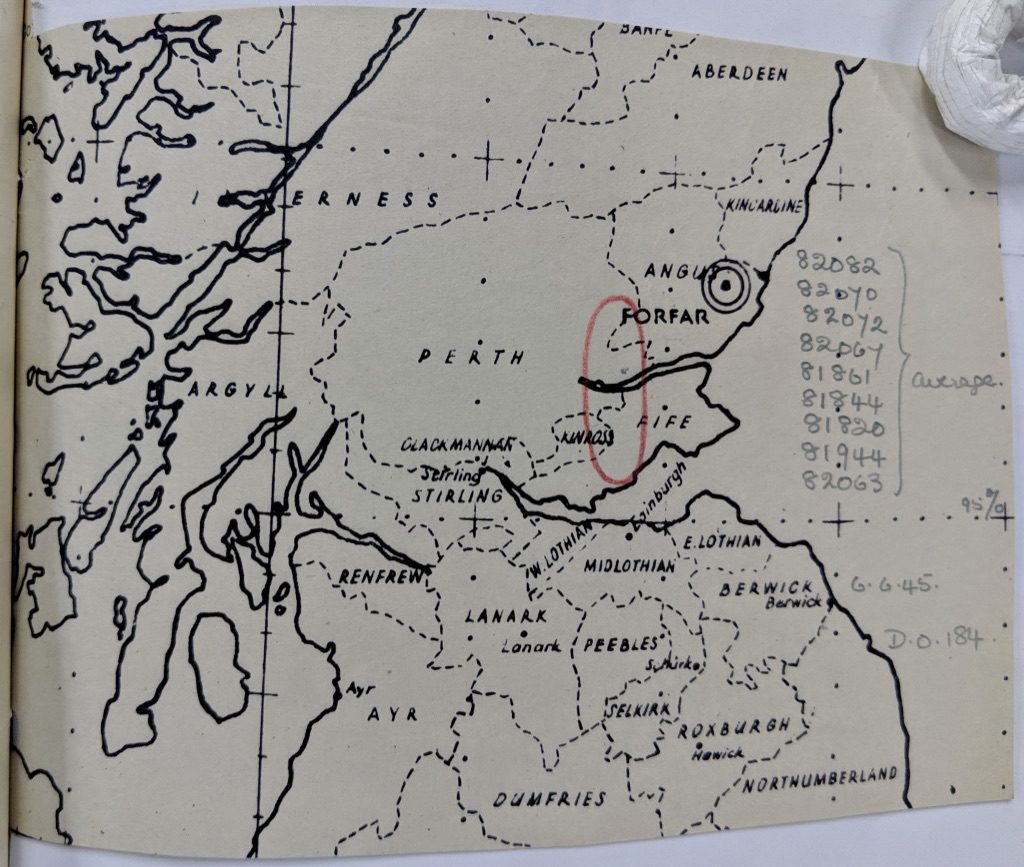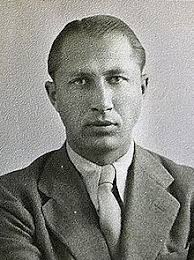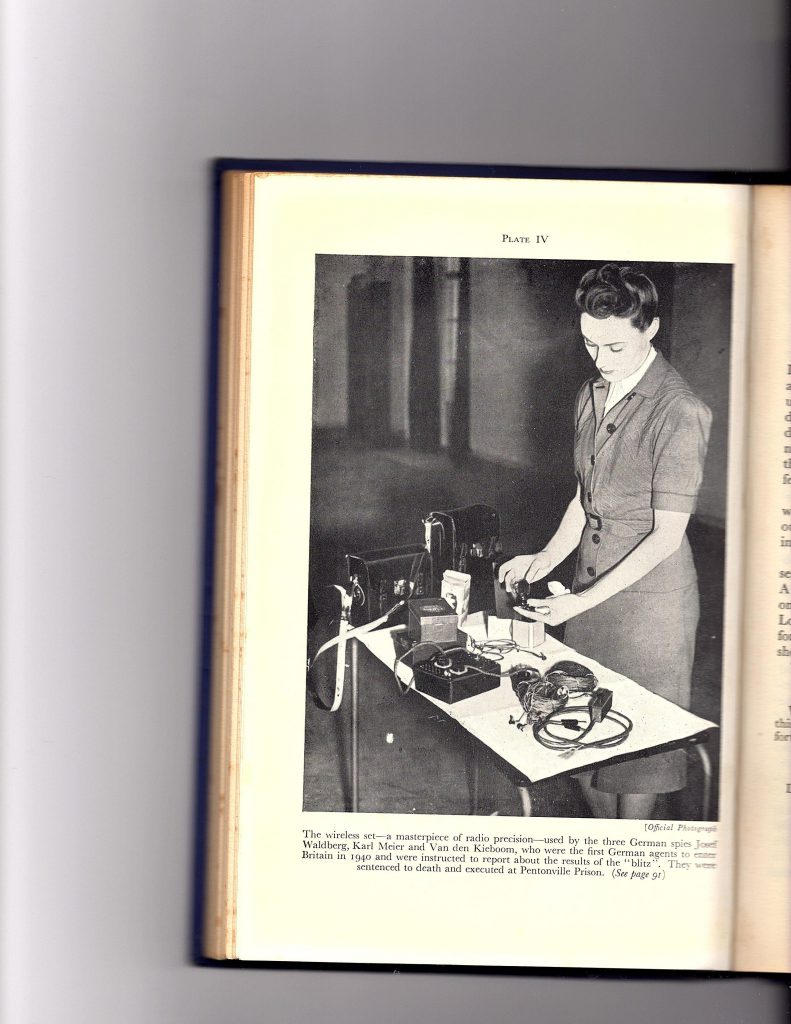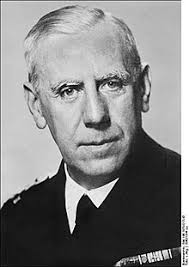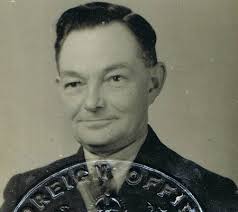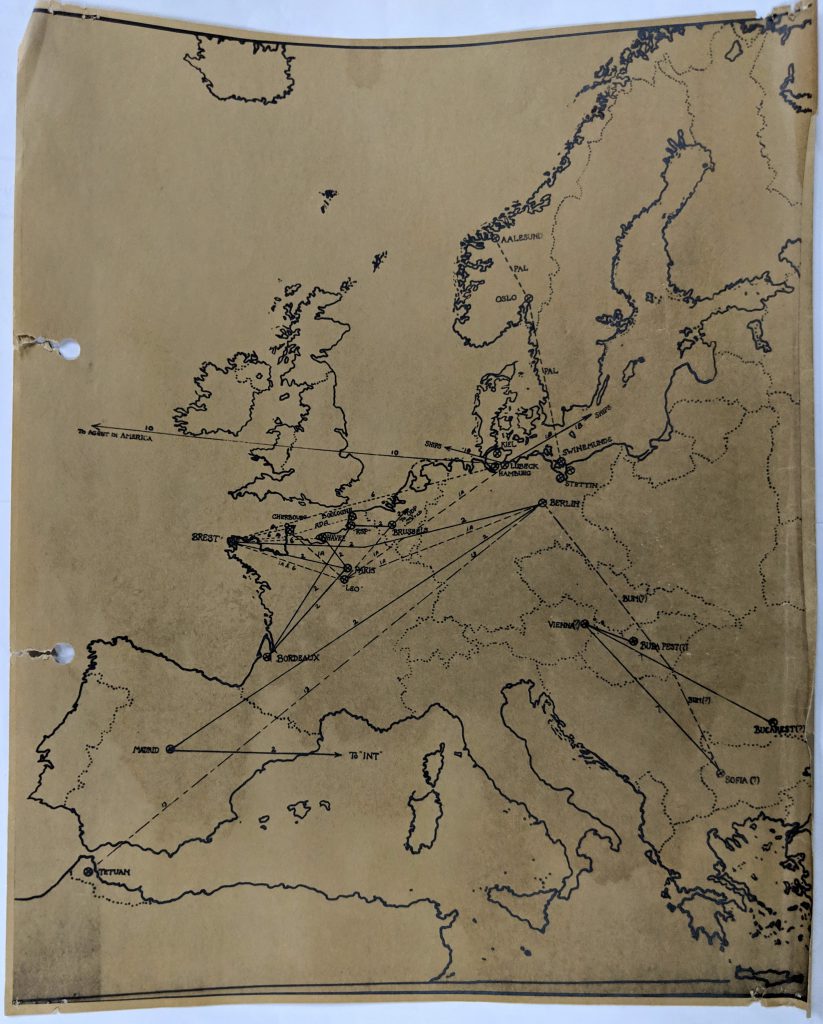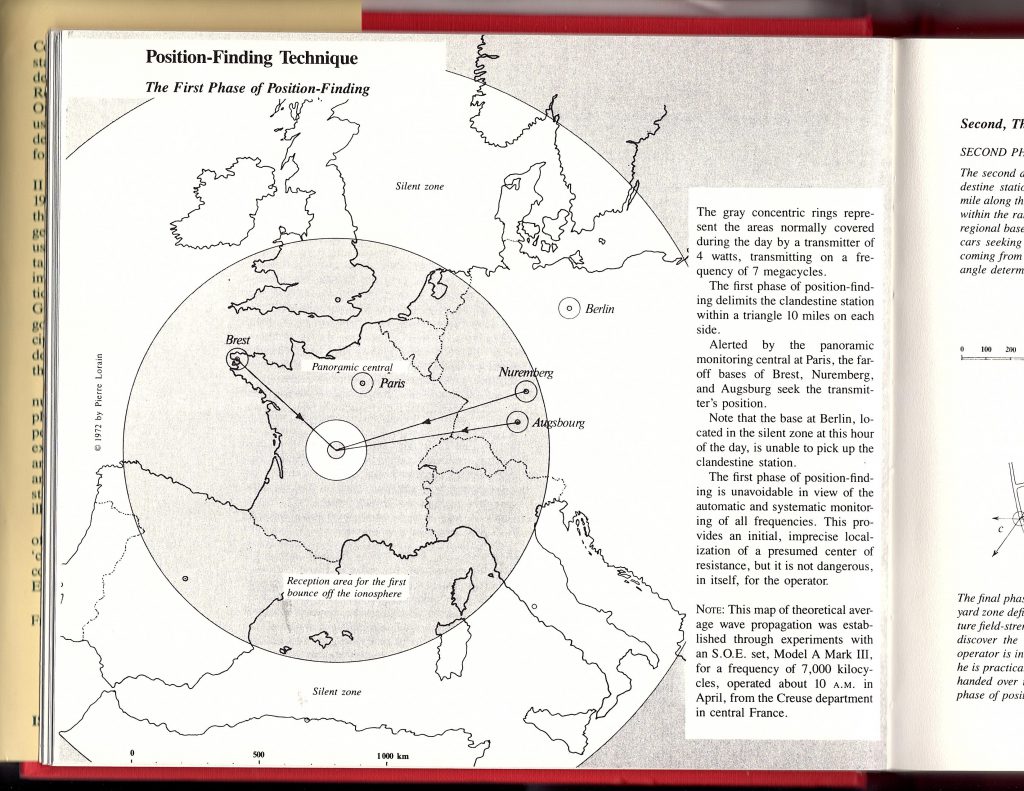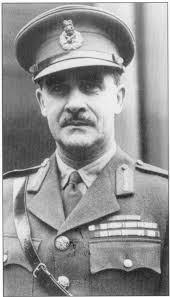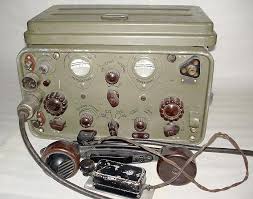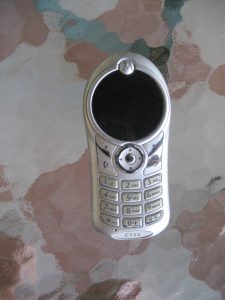
The time has come to try to tidy up five threads of my research concerning wartime wireless usage in Britain, namely Sonia’s Radio; Sonia and the Quebec Agreement; The Mystery of the Undetected Radios; HASP: Spycatcher’s Last Gasp; and Sonia & MI6’s Hidden Hand. The puzzle remains: why was Sonia’s wireless activity not detected? Central to the whole inquiry are the circumstances of a crowded island, in wartime, when the intelligence services had a heightened fear of German spies, one that was communicated to the public at large. In addition, a well-trained unit, the Radio Security Service, was charged with identifying illicit wireless traffic. The probability must therefore be extremely low that a German-speaking woman with a known shady and subversive past could have contrived to outwit the authorities for so long without even having to resort to the traditional practices of concealment and avoidance that wireless agents infiltrated into mainland Europe had to pursue.
Therein lies the paradox to be resolved. That is why it is necessary to inspect very closely the various claims that she (and others) made about the frequency and extent of her transmissions.
The primary conclusions from my previous research can be summarised as follows:
Sonia’s Radio: Sonia’s most important radio transmissions probably occurred from Kidlington, and then from Summertown, Oxford, during the critical period that she handled Klaus Fuchs (October 1942 to December 1943). From September 1943 (when she and her husband, Len Beurton moved to Summertown after his arrival from Switzerland), any wireless activity was probably a feint for what I speculated might have been Len’s more clandestine transmissions from Kidlington.
Sonia and the Quebec Agreement: Chapman Pincher referred to some unverifiable wireless traffic stored by the GRU that appeared to confirm the fact that Sonia transmitted by wireless details of the 1943 Quebec Agreement about atomic research cooperation. For evidential and logistical reasons, this theory should be discarded.
The Mystery of the Undetected Radios: The London Controlling Section and B1A of MI5 displayed a degree of folly in managing its double-cross agents that was matched only by that of the Abwehr in reacting to what was going on. The so-called ’double-agents’, especially GARBO, were, under control, allowed to communicate from stationary positions for absurd lengths of time during a period when the country was on heightened alert. Those officers in the Abwehr who doubted the reliability of their agents were essentially quashed because it suited the careerists to maintain the fiction, and the successor organisation, the RSHA, was unfamiliar with the background. The RSS’s capabilities for detecting illicit transmitters on home territory were much weaker than the authorities claimed at the time, or after the war.
HASP: Spycatcher’s Last Gasp: Peter Wright’s memoir contains a high degree of fabulizing. His account of the HASP traffic is incoherent, and his described search for the missing recordings of Sonia’s transmissions an exercise in self-delusion.
Sonia & MI6’s Hidden Hand: The escape to Britain by Sonia, and the eventual return of her husband, Len Beurton, to join her, were part of an elaborate plot by MI6 (with MI5’s connivance) to use the pair as some species of ‘double-agent’ – a scheme that went tragically wrong.
I thus inspect the conventional ‘journalist’s questions’ of How? What? When? Where?, supplemented by an analysis of Why?
- What equipment did Sonia own in Britain?
- How did she acquire it?
- When and where did she use it?
- Whither did she transmit?
- Why did she need to communicate by wireless?
- What did she transmit?
- Why was she not detected?
1) What equipment did Sonia own in Britain? How did she acquire it?
What is notable is that, as Sonia’s career in illicit wireless transmission progressed, she revealed, in her memoir Sonya’s Report, less and less about the details of the experience. Her account runs as follows:
P 105 She learned to build transmitters, receivers, rectifiers and frequency meters in Moscow
Pp 119-120 In Shanghai, in 1934, Sonia and Ernst bought parts for a transmitter (not available in Mukden), and stowed them away in luggage. The transmitter parts consisted of smaller pieces and two valves the size of a milk bottle. There were no parts available to build a transformer, thus they needed to build a rectifier, in Mukden. Ernst went back to Shanghai, found one and hid it inside a heavy armchair.
P 125 shows a picture of their house in Mukden with two bamboos holding the aerials.
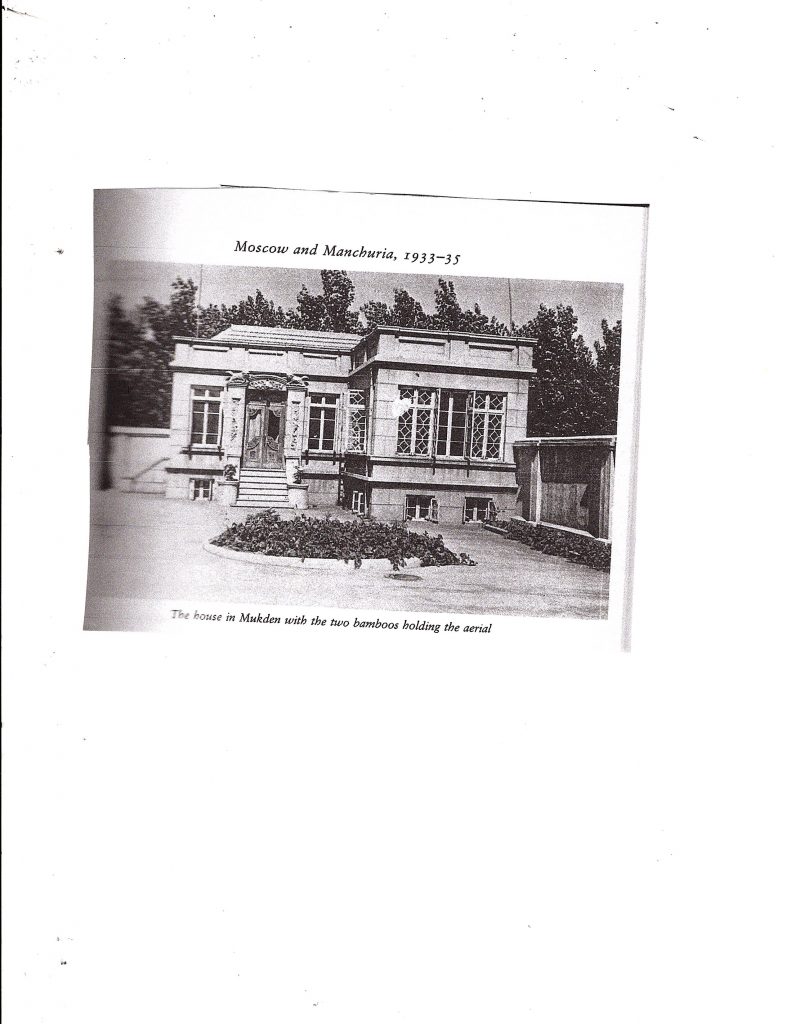
P 126 They used the same type of transmitter that Max described in the book Dr Sorge signals from Tokyo by Julius Mader (1966). The transmitter could be constructed from receiver parts, though even these were not readily available. It was a Hartley transmitter with a three point system. “We did not however – as Max did three years later – omit the rectifier, with its component transformer that caused us so many headaches.” The equipment was of massive proportions: it could not be dismantled every time. It contained a heavy rectifier, large valves, coils made from heavy copper tubing. The coils took more space than the whole transmitter a decade later.
P 127 A year later Ernst fitted the transmitter into a portable gramophone. He bought an American textbook for radio mechanics. Sonia, however, was not as expert a builder of transmitters as Ernst was. The transmitter’s signal was weak, and the Vladivostok end frequently jammed.
P 128 Listening was a torture: 500 groups (of five-figure enciphered characters) might take half the night. ‘We could only select one of two frequencies because with our length of receiver aerial the transmitter only worked on a specific wavelength. It was called a Fuchs aerial.” Sonia expressed amazement that the station was never discovered with regular operation (3 or 4 times a week from the same location). Sonia left China in the autumn of 1935. Before she left,she had caused a short-circuit in a hotel room in Peking, bringing the whole hotel into darkness.
Pp 136-138 By early 1936 Sonia had been established in Poland. She set up the transmitter, which she had had to build on her own, in a suburb of Warsaw, in a ground-floor flat. Again, it was constructed in an empty gramophone case. Yet it worked: she received a reply at once. (Maybe distance had something to do with it.)
Pp 163-168 Sonia moved to Danzig, and needed the privacy of a detached house for her transmitter. Unfortunately, humming sounds made the signals inaudible, a noise that she traced to a nearby power station. Thus she had to move to another apartment block, whence she sent messages twice a week. Yet she gained another valuable lesson: her neighbour pointed out that she was experiencing interference on her radio, and informed Sonia that her husband suspected someone was making secret transmissions. Nevertheless, Sonia persisted, and went on the air once more. She foolishly did not change the transmission time to make it later (and thus reduce the detection risk, although it might have required co-ordination of her proposed schedules with Moscow), or move to a fresh location.
Pp 169-171 By March 1937, Sonia had moved back to Warsaw. She used two batteries each of 120 volts, and, on one occasion, she received a severe electric shock from her equipment. She wrote that her comrade Andrei had informed her that sunspots were causing interference with radio communications, although this might have been based on a misunderstanding of how sunspots affect optimum frequencies.
Pp 184-185 After a recall to Moscow (which she survived, in the middle of the worst purges), Sonia returned to Poland, where she had to help a young comrade by building his transmitter. She transmitted only once a fortnight, and was recalled again in June 1938.
P 191 By September 1938, Sonia had been despatched to Switzerland, where she set up her transmitter. It had to bridge a distance of over 2,000 km. She constructed it in her linen cupboard, and started the schedule early: communication with Moscow was good.
Pp 204-207 By October 1939 (i.e. after war broke out, and amateur radio communications had been forbidden), she was using the transmitter two nights a week. She helped her colleague Hermann construct his, but they had to bury the transmitters when observation intensified. She dug it up again with Len Beurton, and a friendly carpenter made a closet for it. It was concealed in a one-and-a half-metre deep hole in a shed.
P 217 The transmitter was used to the full to help Radó (the leader of the Swiss cell), but
in December 1939 Hermann was arrested during radio work in Freibourg. Sonia thus stopped transmitting for a while
P 227 Now Sonia was transmitting from the Hamels’ kitchen, in Geneva.
P 228 Sonia left for the UK in December 1940.
P 240 She was short of money. Nevertheless, after a few weeks, she wrote: “I had already bought all the transmitter parts and worked on them between praying and playing cards in the Rectory. It could be in operation within 24 hours.”
Pp 242-243 Sonia claimed that she used her transmitter twice a week. Sergey (her contact from the Soviet Embassy) gave her a small parcel, 8 by 6 inches, which contained a small transmitter. It was reliable, handy and technically superior. She therefore dismantled her own transmitter, which was six times the size. Thereafter she transmitted from England for 5 or 6 years.
P 250 Amateur transmissions were forbidden. Sonia therefore had to count on her transmitter being discovered at some point. Thus she sought out ‘Tom’ as a back-up.
Sonia assuredly learned some lessons from her worldwide experiences. Having struggled early in her career, she gained in competence in both constructing and deploying wireless equipment. She was aware of the many problems: for instance, that signals could interfere with local domestic wireless reception, and that, similarly, local power sources could interfere with the quality of transmissions. She knew that transmitting from the same location was inherently dangerous, and she thus expected to be detected. She must have concluded that long-range transmission and reception were haphazard enterprises, although she reflected some misunderstandings about phenomena such as sunspots. And she learned that a well-disguised hiding-place was vital to elude the eyes of the authorities. Yet in one aspect, her account is very puzzling: she writes much about her transmitters, but never about receivers, which are much more complex items of equipment.
As for her account of her wireless work in Britain, she reflected a very careless attitude. Indeed, if one judged her radio-activity on the strength of the details on her equipment she provided, one might conclude her operation was meagre. Moreover, in her memoir she skated over a highly challenging part of her experience. How on earth was she able to buy the parts she needed, over the counter in wartime Britain, when the ownership of unauthorised wireless transmitters was illegal, and the challenges of constructing a receiver were substantial? To quote what my on-line colleague, Dr. Brian Austin, an expert in radiotelephony, has written on these matters: “A sensitive and selective receiver is a far more complex electronic device than a keyed power oscillator which is all a Morse code transmitter has to be.” Dr. Austin (in a review of Ben Macintyre’s Agent Sonya) went on to explain that none of the necessary components could have been purchased in the local hardware stores, especially in wartime, and continued: “Most vital of all, though they never received so much as a mention, were the quartz crystals that determined the transmitter’s frequency. To have used such a precise frequency as 6.1183 MHz, as Macintyre informs us, is only possible when a quartz crystal is the frequency-controlling element. And the ionosphere, so very frequency-dependent, never got a mention either. The antenna, as vital as anything, received no more than a fleeting comment.”
Yet it should be recalled that, according to the telegram sent by BRION (now believed to be Shvetsov) from the Soviet Embassy in London to Moscow on July 31, 1941 (see VENONA Documents – July 1941 (nsa.gov), Sonia, when she had a meeting with Apthekar (GRU cryptonym IRIS), claimed expenses of £105 on ‘radio and microdots’ purchases. It does not appear that she had been able to make any earlier claims, since one entry is for seven months’ salary, and thus, since she had described meeting Apthekar (known to her as SERGEY) in May, and informed him that she could have her transmitter in operation ‘within 24 hours’, one must assume that she had completed the exercise then. £105 presumably covered her total expenses. Dr. Austin very reasonably casts doubt not only on the fact of Sonia’s acquisition and assembly of the equipment, but also its deployment (which I shall address later). So what is the evidence that Sonia did in fact possess a transmitter/receiver, and how might she have obtained it?
The most famous is the police visit to Summertown in January 1943, when Detective-Inspector Rolfe reported to the Chief Constable, Charles Fox, that a visit to the Beurtons’ house in George Street, Summertown, Oxford had revealed that the occupants ‘had rather a large wireless set and recently had a special pole erected for use for the aerial’ (KV 6/41, sn. 55a). This had all been engineered quite openly, as Sonia had in fact asked her landlady, Mrs. Sissie Laski, the wife of Neville, for permission to erect the aerial (antenna) from the roof of their cottage, and link it to one of her landlady’s stables. Some commentators have suggested that this could have been presented as for reception only, but it was a flamboyant request, and should have merited deeper investigation than actually occurred by the Police Force or by MI5 – especially since the Beurtons were considered suspicious persons at that time.
Much of the evidence comes from her offspring. Thus Maik Hamburger, in his memoir of his mother, The German Riveter (see: https://www.eurolitnetwork.com/the-german-riveter-my-mother-sonya-by-maik-hamburger ), wrote, of the house called The Firs: “ Living in Great Rollright, a little village in the Cotswolds, Sonya achieved the apex of her career: she recruited the German-born physicist Klaus Fuchs, who lived in Birmingham and was employed in top-secret research work on the atomic bomb. Fuchs provided her with large quantities of classified information about the development of the bomb, which she duly passed on to her central office in Moscow. Whenever the material was too bulky or contained too many formulae for sending in Morse code, she deposited it in a secret letter-box in Great Rollright for a Russian agent to pick up.” Yet the occupation of The Firs took place after the war, and Maik’s testimony raises further serious questions [see below].

Both Maik (Michael) and his sister, Janina, gave accounts of Sonia’s busy nights enciphering, transmitting to Moscow, and deciphering. Ben Macintyre reports (p 235) as follows: “By the end of 1942, Ursula was transmitting two or three times a week. Little Michael wondered why his mother often slept in the afternoons: She was frequently exhausted from working through much of the night.” And, indeed, Sonia explained that her sending Michael off to boarding-school in Eastbourne was largely to protect him from learning more about her nocturnal transmissions. In her memoir Die Tochter bin ich, Janina wrote (p 50), of the period when she returned to the house at Great Rollright from school:
Manchmal schlief meine Mutter um dies Zeit. Das taten andrere Mütter im Dorf nicht, und ich dachte: Mich schickte sie Unkraut jäten, und sie will schlafen. Wir wußten ja nicht, dass sie nachts oft überhaupt nicht oder or zwei Stunden schlief. Sie mußte nicht nur den Sender bedienen and Funksprüche aus der Sowjetunion aufnehmen; die Funksprüche kamen in Zahlen an, und sie mußte sie gleich nachts nach einem Geheimcode entziffern and das Papier verbrennen.
[Sometimes my mother slept at this time. That wasn’t something the other mothers in the village did, and I thought: She sent me out to pull up weeds, while she insisted on sleeping. Of course we didn’t know that she managed only one or two hours’ sleep, if any, during the nights. Not only did she have to handle the transmitter and wireless messages from the Soviet Union; the messages arrived in bunches, and she had to do her enciphering according to a secret code, and then burn her worksheets.]
While not precisely dated, these observations would appear to describe some time in 1947 or 1948, as all three children were attending school, and working in the garden, and the time referred to was after the famed holiday in Wales, at Butlin’s. (Peter was born in November 1943.) While this timing of Sonia’s afternoon naps has significance [see below], it is, of course, amazing that the poor woman found any time to do any espionage. Moreover, I received a communication from Mr. Roy Vincent a couple of years ago. He had been a lodger with the Beurtons at Great Rollright in 1947-48 (and, as an important sign of verisimilitude, recalled Nina’s interest in Princess Margaret). He wrote to me as follows:
Her daughter Nina was there, and her son Peter came occasionally. Peter told me that his mother had a radio in the basement, but of course to me the radio was just the normal kind – I never saw it, the door to the basement was always kept locked, but there was one occasion where it was left open, and regrettably I did not go down for a look.
I do remember though that there was a wire which came through the wall (or maybe behind some furniture) and went through a hole in the ceiling, which knowing what I do now was the radio antenna.
Mr. Vincent’s testimony is probably more reliable than that of Sonia’s son and daughter, however, or even Sonia herself. In his Introduction to Agent Sonya, Macintyre writes that she had ‘in the outdoor privy behind The Firs . . . constructed a powerful radio transmitter’, leaving it ambiguous as to whether she had built it there (as opposed to transporting it from its previous location), or had operated it there (not in the basement, then). One might also question why, since the miniature transmitter that Sergey had given her was, by Sonia’s account, able to replace her large, clumsy apparatus, she did not just use her new set . . . Another gross error is the fact that Maik asserted that his mother recruited Klaus Fuchs while she was living at Great Rollright. The meeting with Fuchs, however, had been set up in October 1942, and Fuchs left for the USA in December 1943, so Maik’s memory is clearly at fault. His account of his mother’s dropping material in a hiding-place in Great Rollright is pure fantasy, and in contradiction to how his mother even described the process. And is there a possibility that son and daughter were coached to communicate the identical message about Sonia’s sleeping habits, separated by several years? As I shall explore later, it is difficult to imagine what could have occupied so much of Sonia’s time on the wireless in 1947-1948, and her own testimony indicates that she had lost contact with her controller by then.

Lastly, for this section, is the matter of electricity. The fact that there was no current to the house at Great Rollright was described by Sonia (p 267), and echoed by Janina (p 40). Why Sonia would have selected premises lacking electric current if she had important espionage reports to deliver by clandestine wireless was overlooked by the ace agent when she and the GRU compiled her ‘memoir’. This story was nevertheless picked up by Ben Macintyre without the author’s considering how a transmitter-receiver could have been operated so extensively on battery-power alone, or how such batteries would have been charged and the voltage converted. In successive sentences, Sonia described the lack of electricity as well as the potential problem of having tenants, which might impede her radio work. The paradox of such circumstances apparently did not occur to Janina, either. Roy Vincent, however, assures me that the house was electrified, as he recalls a power-cord in the bathroom. In fact Janina remarked (p 43) that it was not until a year after the war that the village was hooked up to the power network (‘Strom erhielt’).
Moreover, it is much more likely that Sonia’s equipment was provided to her by the Soviet Embassy. Such devices were often brought over in the diplomatic bag, which, after the Soviet Union entered the war in June 1941, was often helpfully ferried into Britain by American ‘Liberator’ aircraft. In her memoir, Sonia reports that her contact, Sergey, handed her a miniature transmitter, probably in July 1941, measuring 8 by 6 inches (and an unknown third dimension), and that she was able to dismantle her existing transmitter. She was then able to conceal the new device in a wall when she moved to the cottage in Summertown, but how this miniaturized device stored enough power for the transmission to Moscow was not explained. (What she did to conceal the receiver is not recorded.) Thus, if she did engage in long-distance radio transmission, it was highly probable that the Embassy provided her with her equipment, crystals and all.
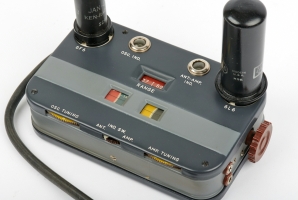
(Dr. Austin has recently shown me evidence that the Soviets had constructed a miniaturised three-piece set of receiver, power-supply unit, and transmitter, known as the ‘Tensor’, and delivered it to its agents in 1942. See https://cryptomuseum.com/spy/tensor/index.htm , and I was able to verify such details in my copy of Meulstee’s and Staritz’s Wireless for the Warrior, Volume 4. This equipment is remarkable, as the receiver (on the right) has dimensions that closely resemble what Sonia described, but serious questions remain. Sonia indicates that she was supplied with her new transmitter in 1941, i.e. before this package was shipped. She never refers to the other two units, but the transmitter would have been useless without the power-supply component. It is not clear that she would have been able to operate such a new device without training. Moreover, I would judge that this equipment displays an unlikely degree of sophistication for 1942, at a time when Hitler’s armies were at the gates of Moscow, and Soviet factories were being dismantled and moved behind the Urals. The Soviet Union was also very dependent upon Great Britain and the USA for manufacturing materials. Intriguingly, the set’s inscriptions are in English. This topic will have to be studied elsewhere – and not by me – but it shows how complex the mythology behind Sonia’s wireless usage is.)
2) When and Where did Sonia transmit?
I next turn to the substance of her transmissions. We should recall that not a single verifiable transcript of any message that Sonia was reputed to have sent (or received) has been presented by any authority. The suggestive sources are as follows:
- Evidence from VENONA (intercepted Soviet diplomatic and military intelligence traffic)
- Sonia’s claims
- Claims from the Soviet Ministry of Defence
- Ben Macintyre’s claims
- Chapman Pincher’s claims
- Peter Wright’s claims
- Bob King’s claims
Evidence from VENONA:
The most famous of the accounts of Sonia’s activity come from the telegram identified above, sent at the end of July, 1941, where BRION (Shvetsov) informed his bosses that Sonia had tried to contact Moscow on the immediately preceding four successive nights (July 26-29), without success. This phenomenon is vaguely echoed in Sonia’s memoir, but brought forward. She wrote (p 242): “After Hitler’s invasion of the Soviet Union, several days went by without response to my call-sign, but then they came on the air again. I used the transmitter twice a week.” Since Barbarossa was launched on June 22, that would indicate that Sonia successfully made contact by the end of that month, and then settled into a regular and successful interchange of messages. Sonia indicated no interruptions of service during this period, stressing only the richness of the information she received from her brother, her father, Hans Kahle, and military contacts, which all resulted in her being able to compile four to six reports a month. So what was Shvetsov’s appeal all about? Was he simply reporting a failure that was never resolved? Was Sonia merely boasting?
Of course, if Sonia had failed to get through to Moscow, Sergey may have told her to abandon the idea, and simply use the miniature new set he had handed her to communicate with the embassy in London instead . . .
Sonia’s Claims:
Because of the contradictions and errors that Sonia and her children made about her wireless ownership and deployment, the claims that Sonia made about her level of busyness have to be processed with a certain degree of scepticism. She stated (Sonya’s Report, p 243) that she transmitted from England for five or six years (1941-1947, in that case).
Occasionally, she supplied examples of the content of messages that she sent. Hence (p 259), she claimed that, after a comrade ‘with worthwhile military information’ had turned to her brother, Jürgen, and the latter sought her advice. “I sent a coded message to Centre and received the reply that contact should be established. The name of this comrade, Klaus Fuchs”, she wrote. Frank Close, Fuchs’s leading biographer, has accepted Sonia’s account of this set-up completely, but why stress ‘coded’? Were other messages not ‘coded’? And it would have been poor spycraft if Fuchs’s name had been given to her by Moscow Central. After one of her trysts with Fuchs, she coded (so she wrote) Fuchs’s questions for Moscow, and decoded Centre’s replies for him. Centre twice acknowledged his messages with ‘important’ and ‘very valuable’ – which seems somewhat of a distortion, as, by all accounts (including that of Fuchs himself) they met only two or three times in total. The unlikelihood of the whole saga was reinforced by the fact that Sonia then stated that ‘about two years after we had started working together, Centre asked me to arrange a meeting for Klaus in New York.’ By all accounts, Sonia first met Fuchs some time between July and October 1942: he left for the USA in late November 1943. Unless a great new secret lies behind this disclosure, we must conclude that her sense of time was shaky.
Towards the end of the war, in the autumn of 1944, Sonia claimed that Jürgen asked her to gain approval from Moscow for his joining the Office of the United States Strategic Bombing Survey. When it consented, and she was able to pass on the good news, Jürgen joined, and was able to give her reports, such as the estimates of current enemy arms production, which Sonia ‘passed on to Centre’. Not only is this behaviour quite out of character for Jürgen, why he simply would not have passed on such reports to his contacts at the Soviet Embassy is never explained. At the end of the war, Sonia ‘had no contact with Centre for several weeks’. In the summer or autumn of 1946, according to her account, Centre broke off contact with her. The Vassiliev archive, namely in Yellow Notebook Number 1, p 86, claims it was even earlier: “Since January 1946, S. has been inactive, and no personal contact with her is maintained.” (January 1946 would have been in the Days before Electricity, in any case.) And that means that Janina’s story about her mother’s exhaustion because of night-time wireless work in 1948 is pure hokum.
Claims from the Soviet Ministry of Defence:
I reproduce here, verbatim, two paragraphs from Chapter 8 of Sonia’s Radio:
The earliest indication of Sonia’s activity appears to be given by an entry in the files of the Soviet Department of Defence, if the transcripts of these documents, which have authoritative-looking identifiers, can be relied upon. (They have been provided to me by a source who prefers to remain anonymous: I suspect they derive from the possessions of a CIA agent, who acquired them by undisclosed means.) It records that ‘soon after Sonia arrived in Britain and established radio communications with Moscow Centre, Ivan Proskurov, then head of Military Intelligence, responded with a message of encouragement’, and two days later (the entries are sadly not dated) sent her detailed instructions. “The assignments on information remain the same. Pay special attention to obtaining information concerning Germany, its army and military economy.” The first message signed off with ‘Warm regards to you and your kids. Regards from Frank [the codename for her ex-husband, Rolf Hamburger].’
I see several reasons for questioning the authenticity of (many of) these documents. First of all, the language here is avuncular and unbusiness-like, very much out of character for normal communications between Moscow and its agents. Rudolf was at that time under detention by the Chinese, causing the Soviets to request his release in June, so was hardly in a position to send his ex-wife his regards. The documents are undated, but the ‘soon after’ (and I am not sure who made that clarification), suggests to me ‘weeks’ rather than ‘months’. Sonia arrived in the UK in early February 1941, but did not construct her transmitter until late May, and made her first contact with the Soviet Union in late June, apparently. It is not totally bizarre to imagine that, even during the time of the Nazi-Soviet pact, Moscow might be seeking dramatic new intelligence on Germany’s army and military economy, but it is absurd to suppose that Sonia, as a new arrival in Britain, would be in a position, from the Oxfordshire countryside, to identify, cultivate, and recruit agents with fresh knowledge in that domain. Moscow already had her brother, abetted by his father, openly giving information to the Soviet Embassy. I have to conclude the documents are fakes, disinformation designed to show, retrospectively, the honourableness of Soviet espionage aims at the time.
I have no reason to change my assessment.
Ben Macintyre’s Claims:
The author of Agent Sonya takes every opportunity to boost his subject’s wireless activity, faithfully reproducing the claims she made herself, and magnifying the importance of her ‘network of spies’. “In the course of a year the Sonya network expanded to include at least a dozen spies, providing a wealth of intelligence: military, political, and scientific”, he writes (p 235), while her brother and father ‘tirelessly hoovered up information and gossip’. This rich seam of ‘intelligence’ had to be processed. “All this intelligence had to be marshalled into reports, coded, and sent to Moscow.” By the end of 1942, Ursula was transmitting ‘two or three times a week’, observes our intrepid researcher.
Yet Macintyre shows a combination of vagueness and unjustifiable precision. He describes the content of the messages that Sonya received from Moscow Centre after Operation Barbarossa: “When she finally established radio contact, Ursula found the Centre avid for intelligence about Britain. What were the politicians and generals really thinking? How sincere were Churchill’s words? Would Britain support Russia?”, he dramatically declares. No source for these messages is given: Sonia’s memoir includes no such precise testimony.
The only occasion where Macintyre reproduces, apparently verbatim, a message from Moscow occurs during the negotiations over Klaus Fuchs. He writes that Jürgen had taken Ursula aside at a family gathering in Hampstead in July 1942, and told her ‘a physicist by the name of F. had lost contact with a representative of the Soviet Embassy’s military department, who called himself “Johnson”’. (JOHNSON was Simon Kremer, the military attaché, who had indeed returned to the Soviet Union that summer.) When Sonia returned to Kidlington that evening, she sent a message to Moscow requesting instructions. “The Centre responded: ‘make contact with OTTO’.” Macintyre’s source for this factoid is Frank Close’s Trinity. Close, in turn, cites the Vassiliev Yellow Notebook Number 1, p 86, which refers to a GRU memoir of Fuchs.
That passage can be verified, and runs as follows: “On 22.10.42. ‘Sonya’ informed our worker that her brother, J. Kuczynski, had told her that in July 1942, a physicist by the name of F had lost contact with a member of the Sov. Embassy’s military department who called himself Johnson. ‘Sonya’ also reported that at Kuczynski’s suggestion, she already established contact with F., received materials from him, and asks us to indicate whether she should continue to maintain contact with him and accept materials from him. On our instructions, Sonya continued to maintain contact with F . . .” Chapman Pincher, incidentally, suggests that Fuchs attended the Hampstead gathering in July, and may have passed materials on at this encounter.
Careful readers will have noticed that there is no record, in the Notebooks, of Sonia’s rushing home to gain Moscow’s permission in July 1942, and certainly no confirmation of a ‘Make contact with OTTO’ message. In fact the item indicates that Sonia contacted Fuchs without any explicit permission from Moscow, and then informed her local contact (‘our worker’) by word of mouth of what she had done, rather than communicating by wireless. This is, in fact, the way that Pincher presented the events, with Jürgen, acting on GRU instructions, suggesting to his sister that she act as Fuchs’s courier, to which Sonia immediately assented, with Jürgen giving her details for a meeting in Birmingham. One might also wonder, if Moscow had given her sharp instructions to contact ‘OTTO’, why she had waited so long to make the assignment, or, if she attended to it promptly, why she took so long to report it. Wireless appears to have played no part in the project.
Macintyre categorises the secrets that Fuchs handed on as ‘one of the most concentrated spy hauls in history’ (p 232), but, nevertheless, still implies that Sonia transmitted a considerable amount by wireless. He appears to have accepted Maik Hamburger’s nonsensical ‘testimony’ at face value in this regard, ignoring the anomalies of time and space. “Much of this material was too complex and too technical to be coded and sent by radio”, he writes, thus declaring that Sonia still used the highly problematic medium for a sizable proportion of Fuchs’s material, even though she had a reliable channel to the Embassy established. I shall explore this apparent paradox later.
Chapman Pincher’s Claims:
When Chapman Pincher made his assertions about Sonia and the Quebec Agreement in Treachery, he claimed that ‘the Russian archives’ provided the evidence for Sonia’s leakage of ‘all the essential aspects of the Quebec Agreement’ (pp 16-17). This comprehensive report, laboriously encoded, enciphered, and transmitted, had, as ‘the GRU archives’ confirmed, impressed Stalin, as it went beyond what Roosevelt and Churchill had told him about their agreement in a personal message. No particular file or folder is identified, and Pincher did not provide an authorial source for these claims, although he did state that Dr. Svetlana Chervonnaya had, in July 2011, discovered a document confirming that Sonia had transmitted this information on September 4, 1943. Pincher then went on to write that Sonia had already transmitted at that time the list of the fifteen British scientists selected to move to America.
This is all bunkum, as I showed in my piece. Neither Fuchs nor Sonia could possibly have known the details of the Quebec Agreement at that time, nor which scientists had been chosen, and neither would Roger Hollis, Pincher’s prime candidate for the leakage, have been able to learn of such specific information.
Later, when discussing her interactions with Klaus Fuchs, Pincher played with the notion of Sonia’s role as ‘head of station’ to suggest that ‘Sonya’s Station’ represented her role as an ‘established operator with transmitting facilities’ – ‘Sonya’s Station’ (p 157). He reinforced this notion with a reference to the memoirs of Major General Petrov, a former chief of the GRU Radio-Communications Service, who apparently singled out Sonia’s transmitter as ‘Sonya’s Station operated by Ursula Hamburger.’ Yet Pincher sensibly indicated that the documents passed to her by Fuchs were so bulky, and so unsuitable for converting into Morse code (e.g. ‘100 pages of drawings and formulae’), that she had to take them by train to London ‘for onward passage to the Soviet embassy’. Pincher drew attention to the prominent aerial at the Laskis’ cottage, and rightly questioned why MI5 did not follow up the inspection (p 161), but he did not ascribe a role to it in the Fuchs business.
That was not to deny Sonia’s radio-activity, however. On page 138 of Treachery, Pincher wrote, of her time in Kidlington starting in April 1941: “It is now certain, from the identification of some of her radio traffic, that she was transmitting substantial amounts of material long before she would have had time to find and recruit any new sources of her own.” While this description is belied by Sonia’s own account of the time at which she started exploiting her equipment, Pincher provided no sources for what would be a breathtaking revelation of her traffic.
It seems that Pincher was relying largely on information fed to him by Chervonnaya, as well as three volumes published in Russian, Viktor Bochkarov’s and Alexander Kolpakidi’s Superfrau iz GRU, and Vladimir Lota’s Sekretny Front and GRU I atomnaia bomba. When I previously wrote about the Quebec Agreement, and Sonia’s dealings with Fuchs, I had not had access to any of these volumes. I have now acquired the first two, and can confidently report that the first book contains no reference to the Quebec Agreement, and relies heavily on Sonia’s memoir, while the second, while including photocopies of many useful telegrams from the spy-ring in Switzerland, has nothing on Sonia’s time in the United Kingdom.
Peter Wright’s Claims:
The author of Spycatcher made a number of speculative jumps in trying to persuade his readers that a large batch of Sonia’s transmissions sat somewhere on the planet waiting to be discovered (or re-discovered). It started with the so-called ‘HASP’ breakthrough, in which a lead from Sweden provoked the fortuitous unearthing of a book of trade statistics in the British Library, which in turn allowed a batch of messages sent by Simon Kremer and his meetings with Sonia to be decrypted. “They showed that Sonia had indeed been sent to the Oxford area by Russian Intelligence, and that during 1941 she was already running a string of agents.” Despite the claims made to Wright by GCHQ that she could have not been transmitting from her home between 1941 and 1943 without being detected, Wright was convinced that transcripts of her messages existed. He spent four years, between 1972 and 1976, travelling 370,000 kilometres round the globe trying to find that trove (or so he said).
No matter that the only message possibly concerning Kremer and Sonia that has survived in VENONA is the famous June 30, 1941 message actually sent by Shvetsov. No matter that this message describes a meeting that IRIS (Aptekar not Kremer) had recently had with Sonia. No matter that Kremer had previously acted as a cut-out for Fuchs, but had been withdrawn because Fuchs found him clumsy and furtive. No matter that Kremer has never been recorded as ever meeting Sonia, and was withdrawn from the Embassy in the summer of 1942. No matter that this sole surviving telegram reports on Sonia’s failure to make contact by wireless, rather than her success. Instead, Wright draws on this flimsy set of illogical connections to solidify the case against ELLI. “Once this was known I felt more sure than ever that Elli did exist, and that he was run by Sonia from Oxford, and that the secret of his identity lay in her transmission [sic], which inexplicably had been lost all those years before.”
No further questions, m’lud.
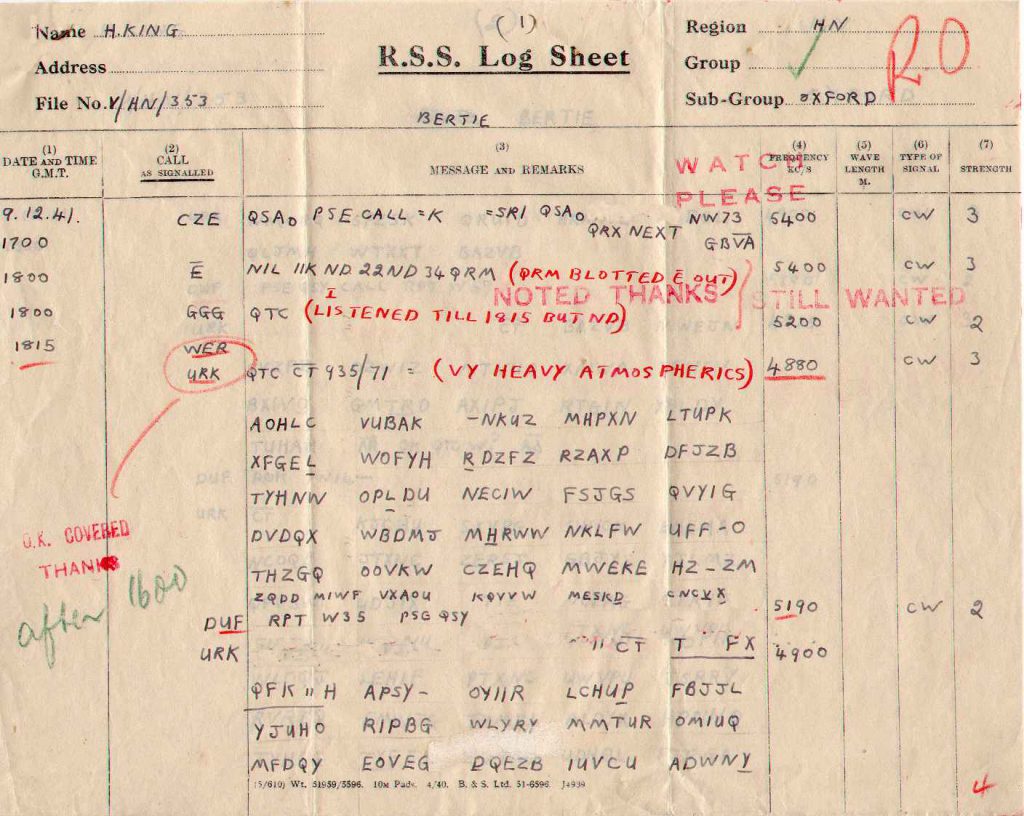
Bob King’s Claims:
Lastly, in this section, I re-present much of a commentary that I provided on the evidence of Bob King, which I reported on in May 2019.
I reproduce here an extraordinary artefact from December 1941 that was passed to me by Bob King, a veteran of RSS. As is clear, it is a log sheet of Mr. King’s as a ‘watcher’ in the Oxford area, where Sonia Kuczynski operated. In an email message to me last summer, Mr. King wrote: “The RSS knew of her [Sonia’s] presence, with over 2,000 widely spread operators listening for any unidentified signals we could hardly miss her. But as she was not Abwehr we didn’t follow her up. I expect someone else did.” He later added: “I can say the tests and good evidence shows that it is unlikely that any illicit transmission within the UK during the war years escaped our notice. If it was not our assignment we dropped it. Whether the information (call sign, frequency, time and procedure, if any) was passed to some other organisation I cannot say. I was informed by one RSS operator that Sonia (he later discovered it was she) was copied and told ‘Not wanted’”.
I was overwhelmed by being able to exchange information with a survivor from the war who had operated before I (now a 72 year-old) was born, and intrigued by Mr. King’s revelations. I followed up with other questions, asking, for instance, how his unit knew that the operator, was Sonia, even that she was a woman. Mr. King replied: “I am sorry but I have no further information. We identified the Abwehr by several means: procedure, tying in with other Abwehr (already known) and such things as operator recognition, note of transmitter and an experienced knowledge hard to describe. It was an operator (I forget who) who wrote to me long after the war saying that he had copied Sonia (this was sometime after 1946 I believe) when I left RSS and had no connection with it at all. Surveillance of short waves continued post-war I understand and exercises demonstrated that transmitters could not go undetected for long. Pre-war a rogue transmission was located by the GPO in many cases, it was their job to catch unlicensed transmitters and post war radio amateurs as well to report a station sending coded messages which in peace time was strictly forbidden. This is why I maintain that Sonia could not have been undetected at any time since. What the authorities did about it I am not in a position to say.’ Mr. King also told me that the Interceptors were instructed to log everything, indiscriminately, on the wavelengths they were responsible for. They could not make independent decisions, say, on listening for overseas transmitters.
When commenting on one of my posts on Sonia, Mr. King summed up his experiences and opinions: “I am convinced that no illicit, or other, transmission audible in the UK could escape detection for long. The whole high frequency spectrum was divided into sections (the size dependent on frequency) and searched regularly by several thousand skilled listeners. All signals, recognised or not, by the operator, were passed to Arkley unless directed otherwise. If not identified by us as Abwehr we either asked for a ‘Watch please’ or ‘Not wanted’. We had several VIs [Voluntary Interceptors] in or near Oxford (I was one in 1941) and I visited a full time one in Somerton so Sonia’s signals must have been reported. In my nearly 5 years at Arkley reading logged reports I may well have stamped ‘Not Wanted’ on a Sonia transmission. There were some inquisitive attempts to discover the ownership of strange signals but I know no more or where information that we had was dealt with. Embassy traffic also I am sure was monitored.”
Chapman Pincher echoed aspects of this account when he wrote (in Treachery, p 141): “James Johnston [a direction-finder operator in RSS] recalled in letters to me that he and his colleagues had intercepted messages from an illegal transmitter in the Oxford area, which he later believed to be Sonia’s, and had submitted them to MI6 or MI5. ‘Our logs recorded her traffic, but they were returned with the reference NFA [No Further Action] or NFU [No Further Use]. This meant that the RSS was not required to send out its mobile detector vans’.” Regrettably, no dates are given. No explanation is given as to how Johnston and his colleagues at the time learned about Sonia, and made the connection between the facts of unidentifiable – and not precisely located – signals and that of Sonia’s presence.
Mr. King has, sadly, since died. Of course, his testimony indicates not incontrovertibly that Sonia did or did not transmit, but proposes that, if she had, she would have been picked up, and thus, if nothing was done about it, it is because the RSS received instructions to ignore her messages. (Incidentally, he overstates the number of Voluntary Interceptors by about 50%.) Yet, in the light of what we know about the set-up at Great Rollright, his colleague’s placement of 1946 for picking up Sonia’s traffic is very dubious. King’s anecdote suggests that he was informed that Sonia had, on at least one occasion, been identified and ignored, but it is not at all clear how he was able to gain that knowledge. It all presents some further paradoxes, which I presented in my HASP piece last year, and which I shall re-examine in the section on Interception below. With the passage of time, Mr. King’s ability to recollect exactly what happened might have been impaired. [I should point out that the Log Sheet that Mr. King provided is one recording an Abwehr signal transmitted from Berlin, and has nothing to do with Sonia.]
3) Whither did Sonia transmit?
In the early 1960s, I recall using my Bakelite wireless to tune into Radio Luxembourg, noticing on the dial, as I did so, such stations as ‘Hilversum’ or ‘Moscow’. Trying to pick up their signals was very much a hit-and-miss affair, but the names and possibilities intrigued me, as I skipped pass all those anonymous morse beeps that presumably came largely from Soviet agents calling home, so that I could settle down with Pete Murray and David Jacobs, and switch off mentally when Horace Batchelor tried to sell me his winning football pools technique. What might I have learned with a little perseverance and expertise?
How easy was it to make contact with Moscow by wireless in 1941? In his Introduction to Agent Sonya, Ben Macintyre writes that Sonia’s neighbours in Great Rollright ‘did not know that . . . Mrs Beurton had constructed a powerful radio transmitter tuned to Soviet intelligence headquarters in Moscow’. Yet transmitting and receiving over a distance of nearly 2000 miles is not simply a process of moving a dial to ‘Moscow’ and pressing ‘Start’.
First of all, the vagaries of the ionosphere have to be dealt with. A journey that long will require more than one bounce off the ionised layer and back to earth. Long-distance transmissions are notoriously unreliable: interference occurs. Sender and transmitter would have to inspect the prospects for such phenomena as (helpful) sun-spot activity, and then select a range of day-time and night-time frequencies, and accompanying times, that would be most suitable for achieving contact (the ‘skeds’, or schedules). The agreement on such skeds required constant communication itself.
Second, precisely manufactured crystals for the frequencies selected would be required. They would not easily be acquired. Third, a powerful transmitter would be necessary. Whereas the sets used by Hitler’s LENA spies to communicate with Hamburg generated no more than about 5 watts (and were underpowered in the hope that that capacity would hinder groundwave detection), transmitting clearly to Moscow might require as much 50 watts of power.
Boosting the 240-volt mains supply of a residential property up to the larger wattage required for the transmitter would require a transformer, the parts for which (chokes and condensers) would have been extremely difficult to acquire in wartime. The miniaturized equipment would have required rectification of the mains AC (alternating current) to DC (direct current). Trying to operate without a mains supply (as Sonia and Maik claimed about operation at the Firs) would impose severe new constrictions for battery re-charging, presenting a practically insuperable challenge for Sonia. One thinks of the extremely heavy wirelesses and batteries that had to be borne by mules when SOE operators were parachuted into Yugoslavia, where there was no easily available mains supply, and the distances to be transmitted were long.
Fourth, and perhaps most important, was the effectiveness of the antenna. In order to transmit to Moscow, unlike the needs of a comparatively local broadcast, Sonia would have required an antenna that was elevated to a height of about 12.5 metres, and was aligned at right angles to the required direction of propagation. That would be distinctly more complicated than the simple horizontal antenna she reported using at Summertown, and much more conspicuous.
The combination of all these factors indicates that Sonia’s efforts to communicate with Moscow would have been extremely arduous, pushing several logistical limits, and would have immediately drawn attention to herself by the invasiveness of her electronic signals, both from her neighbours and from the RSS. If Sonia did transmit, it was more probably to the Soviet Embassy in London. The miniature transmitter that Sergey gave her would have been more suitable for such a distance.
Last is the question of detection. If Sonia was broadcasting to Moscow, the frequencies she would have had to use might have fallen outside the range that the RSS was concentrating on, since it was highly focused on illicit German agents transmitting to Germany (although, if Bob King’s claim is reliable, the service watched the entire spectrum). If she was broadcasting to a closer target, using a range of frequencies in the bands used by the Abwehr, however, it would have been more probable that her transmissions were picked up and noticed – and should therefore have sustained a greater chance of being followed up.
4) Why did she need to communicate by wireless? What did she transmit?
Sonia claimed that she operated her radio for about five to six years. It might be convenient to divide the duration of Sonia’s radio-activity (or non-activity) into four periods:1) Excitement (from June 1941 to about August 1942, in Kidlington); 2) Intensity (from September 1942 to November 1943, in Summertown); 3) Quiescence (from December 1943 to May 1945, in Summertown); and 4) Decay (from June 1945 to 1947, in Great Rollright).
In the first period, of Excitement, Sonia may have been trying to justify her salary. She was a trained wireless operator, of course, and, for whatever reason the GRU sent her to Britain, gathering intelligence and sending it back to Moscow would have shown proof of her commitment. The invasion of Soviet Russia by Hitler’s forces may have prompted a more intensive call for information about political intentions, and arms progress, by her bosses. Her claims of building a spy ‘network’, however, were exaggerated, as she relied on family members and friends to provide snippets of gossip and probably broadly available truths that could be packaged into simple reports that did not tax her resources unduly, or draw much attention.
Yet a recurring question appears. Why, if her brother was in constant touch with the Soviet Embassy, could he have not passed on such information, far more safely, and presumably just as quickly? Thereupon, GRU staff could surely have selected certain information for the diplomatic bag, and other for the dedicated station wireless. GRU-NKVD rivalry may have entered the picture, but even Chapman Pincher undermines his own theories in this regard, in discussing the role of Ambassador Ivan Maisky, who famously vacuumed up all the gossip he could find (or even invent). On page 127 of Treachery, Pincher wrote: “Kuczynski [Jürgen] was friendly with him [Maisky] and may have approached him for advice. Maisky, who allegedly hated the embassy’s KGB representative, Anatoli Gorski, may have then ensured that it was the embassy’s GRU man who acquired the promising new source [Fuchs].”
Furthermore, Pincher, moving ahead to the Gouzenko affair of 1945, then hinted at Sonia’s own relationship with GRU officers (p 139): “In view of the importance attached to Elli by the Kremlin, it is likely that most of his documents had to be passed by a courier to some GRU officer in the Soviet embassy, who would have had local responsibility for him. As has been proved by deciphered GRU cables [??], Sonia was in regular touch with GRU officers there, either directly on her occasional visits to London by train or through a cutout, who could conveniently have been her sister Brigitte, who visited her.”
So much speculation, and so many hypotheticals, but all pointing to the fact that busyness on the wireless would have been a dangerous complication, and that access to GRU resources in the Embassy was not difficult. Indeed, Bochkarov and Kolkapidi confirm the courier role of Brigitte (‘JOYCE’), who had helped recruit Allan Foote after Sonia had left London in 1938.
Sonia’s most productive period (‘Intensity’) was undoubtedly her time acting as courier for Klaus Fuchs. She indicated that she communicated with Moscow on Fuchs’s questions for Centre, and passed on their replies, as if this had been the bulk of her exchanges. She did acknowledge that one ‘thick book of blueprints’ required her to forward it quickly, thus necessitating a complex series of actions involving chalk signs on a pavement in London, and a subsequent meeting outside Oxford the same evening – which all sounds remarkably cloak-and-dagger and improbable. If her contact did not turn up, she had to return to the same location every evening until he did. She did claim that Moscow contacted her towards the end of 1943, asking her to help arrange a meeting-place for Fuchs in New York after his arrival in December.
As I have shown, Ben Macintyre asserts that much of the material that Fuchs gave her was encoded and enciphered, and hence transmitted to Moscow. Yet Sonia could presumably have simply called her brother on the telephone, given him a coded signal, caught the train to London, and handed over the complete package. Jürgen would have been able to walk into the embassy without an eyebrow being raised. Why would she stop and make decisions as to what needed to be transmitted by wireless, what with all the associated hassle, time, and risks? Why not let the GRU officer at the embassy make that determination, namely what should go in the diplomatic bag, and what was more urgent, and non-mathematical, and should be passed over the more secure embassy radio link? It does not make sense.
In 1944, the dispatch of Micha [Maik] to an expensive boarding-school in Eastbourne was attributed by Sonia to the problem of ‘concealing my nocturnal transmissions’ from him when ‘the workload increased, including more meetings in London’. But what were her sources and occupations in this period of Quiescence, after Fuchs had left? Some commentators have picked up on her relationship with Melita Norwood (TINA) as the reason for her occasional activity during this time.
David Burke, in The Spy Who Came in from the Co-op, attempted to unravel this rather tortured tale. First of all, drawing on Vasili Mitrokhin’s access to Norwood’s KGB file, Burke quoted that ‘she was controlled from 1941 to 1944 by an unidentified “head agent” codenamed FIR’, ‘who was also involved in the Klaus Fuchs case’. Burke suggested that the fact that Sonia’s address was ‘The Firs’ was a strong indication that FIR was indeed Sonia, conveniently overlooking the fact that Sonia did not move to The Firs until 1945. He then went on to cite an official history of the GRU, published in 2004 (an encyclopedia of Military Intelligence, apparently), which states that Norwood began passing information to her controller, who was ‘probably’ Ursula Kuczyinski, from September 1941. One might regret the lack of confidence with which such an authority could impart such insights, but let it pass. The history suggests that Norwood was then transferred back to the NKVD, under amicable circumstances, in 1944, when Sonia came under suspicion of being compromised.
Yet several holes in this theory appear. Christopher Andrew and Vasili Mitrokhin, in The Sword and the Shield, unquestioningly picked up the idea that FIR was the NKVD’s name for Sonia, but could not explain why the GRU had adopted Norwood. The London NKVD residency was closed for most of 1940. ‘When reactivated in 1941”, they wrote, “she was for unexplained reasons handed over to SONYA of the GRU rather than to an NKVD controller.” And Burke shows some considerable confusion over these years. In Chapter 1, he declares that Sonia was Norwood’s controller between 1941 and 1944, but never explains how Norwood was assigned to Sonia. Suddenly, during the years 1941 and 1942 (p 126), Sonia was controlling both Fuchs and Norwood. At the end of 1943, however (p 129), we learn that Norwood left the British Non-Ferrous Metals Association (BN-FMRA) to have her baby. On page 132, Burke writes that, coincidentally, ‘as 1943 drew to a close, both Melita Norwood and Klaus Fuchs were taken away from the Kuczynski circle’, but he then echoes (p 134) the Mitrokhin story that Norwood was controlled from 1941 to 1944 by FIR.
Norwood was indeed active in 1945, as is confirmed by the Vasiliev Notebooks, which show (Yellow, Number 1, p 25) recommendations for starting work with Norwood. On June 22, IGOR reported that TINA had made her second removal of documents from her office. The BN-FMRA had been co-opted officially on to the Tube Alloys project in March, when Norwood had been asked to sign the Official Secrets Act. Burke does not identify her new controller, but states that she was meeting him ‘on a regular basis’.
Might the NKGB not have known of Norwood’s previous activity? Or did she perhaps not have access to anything critical beforehand (and thus had not had to sign the OSA)? The account is very sketchy, and confused. And the logistics of Sonia’s being her courier in that busy 1941-1942 period do not make a lot of sense. While occupied with Fuchs, would she have travelled to SE London to meet Norwood, returned home to digest what had been given to her, and then make further decisions as to what she should hand over by returning to London (having set up some special sign for a rendezvous), and then transmitted the rest? FIR was surely someone else.
Nevertheless, Macintyre authoritatively declares that Sonia was Norwood’s controller, though he transposes a 1945 incident concerning thefts from a safe to 1942. Pincher was also a proponent of the theory (while pointing out the problems of servicing Bexleyheath from Oxford), and claimed that Burke informed him that Norwood had told her biographer that Sonia had been her contact. Maybe Burke overcame his scepticism about the shaky etymology of FIR. Yet, after she had been exposed, in 2000, Norwood said that that person was now dead, before Sonia died later that year. Sonia had known Norwood in 1941, as their mothers were friendly, but there is no evidence that Norwood was a productive source before 1945, nor that Sonia acted as her courier before then. We find too many spies not telling the truth, and too many historians and journalists not applying much rigour to their analyses.
As for the period of Decay, no more needs to be written. No power at the house, no contacts to provide gossip or information, and communications broken off anyway. Simply more fabulizing from Sonia and her children. She lugs her wireless equipment from house to house, because it presumably aids her Walter Mitty-like illusions.
Why was Sonia not detected?
Irrespective of how active she was on her wireless, Sonia declared, very reasonably, that she would be detected at some stage. Yet she persisted in the regularity of her broadcasts (or so she claimed), and the permanence of her transmitting locations. That phenomenon might be cited as evidence that she knew she was under some kind of protection. Yet, even if that had been so, it does not explain fully the behaviour of the interception and detection services, who would not have been brought into any highly confidential secret owned and protected by MI5 and MI6.
Two prevailing stories have to be addressed: the official statements of the RSS (and subsequently, after the war, GCHQ), which strongly pointed out that it would have been impossible for Sonia to have evaded the RSS’s ‘detect, search and identify’ machinery; and the unofficial claims from Bob King (and espoused and amplified by Chapman Pincher) that Sonia’s wireless had been identified, but that the Discrimination Section of RSS had been advised that it should be ignored, with Pincher ludicrously bringing in Roger Hollis and Kim Philby as the intelligence officers who protected her. Yet, as I explained in https://coldspur.com/the-mystery-of-the-undetected-radios-part-5/ , https://coldspur.com/the-mystery-of-the-undetected-radios-part-8/ , and https://coldspur.com/hasp-spycatchers-last-gasp/, both these claims have to be explored and tested very stringently. (I recommend readers return to these pieces for a fuller discussion.)
In essence, the RSS was much more sluggish and inefficient in identifying possibly illicit transmissions than it claimed. It had started off with good intentions, under the vision of Simpson, and the administration of Gill, but, after the transfer to MI6 in May 1941, had become distracted under the leadership of Gambier-Parry, and the diversion of focus of interception activity to mainland Europe. While it may have been watching the whole radio spectrum, for a long time it maintained no complete registry of authorised transmitters (e.g. government departments, or units of governments-in-exile), and its ability to send out a rapid-response mobile force was embarrassingly meagre. Thus any wily illicit wireless operator could have outfoxed the authorities.
On the other hand, the claims made by Bob King, the young (17-year-old in 1941) Voluntary Interceptor who later joined the Discrimination Section also demand strict analysis. For the RSS to know that a probable illicit transmission from the Oxford area was assuredly Sonia’s it would have required knowledge that was not disclosed by King. I mercilessly reproduce the logic I used in HASP: Spycatcher’s Last Gasp to explain the flaws in both arguments.
“For GCHQ to be able to deny that Sonia had been able to broadcast would mean that it had 100% confidence that RSS had been able to detect all illicit traffic originating in the area, and that, furthermore, they knew the co-ordinates of Sonia’s residence at that time. Thus the following steps would have had to be taken:
- All illicit or suspicious wireless broadcasts had been detected by RSS;
- All those that could not have been accounted for were investigated;
- Successful triangulation (direction-finding) of all such signals had taken place to localise the source;
- Mobile location-finding units had been sent out to investigate all transgressions;
- Such units found that all the illicit stations were still broadcasting (on the same wave-length and with the identical callsign, presumably);
- All the offending transmitters were detected, and none was found to be Sonia’s.”
By the same token, it would have required such a visit for the RSS to have determined that the transmitter was indeed Sonia’s, and to pass that information on. Of course, had MI5/MI6 then gained that intelligence, it could have thereafter used the pattern of Sonia’s call-signs, fist, frequencies chosen – and maybe even decrypted text – to be able to alert RSS confidently of the characteristics of any future messages, and to advise the unit not to pursue. Indeed, one could interpret the January 1943 visit by the Oxford constabulary to Summertown as just such a follow-up, which confirmed the existence of wireless apparatus at Sonia’s residence.
Thus, unless Sonia did not broadcast at all (a theory that is not totally bankrupt, but then why did she make such a fuss about lugging that equipment around?), we have to face the fact that a portion of the interception story has been permanently withheld. It is more probable that a cat-and-mouse game did go on, where MI6 (and MI5) encouraged Sonia to broadcast, and that she played along, having worked out what was happening. She therefore transmitted only rarely, and sent politically harmless information, which GC&CS may or may not have been able to decipher.
Conclusions
Sonia was a trained wireless operator. Thus the KGB had to boost that reputation when she wrote her memoir, displaying a stunning but improbable track-record of virtuosity, in which the British intelligence services were outfoxed. If Sonia did not broadcast at all, then her memoir is a vast hoax, which has fooled all commentators and historians. If she did send any messages, then the failure to intercept and identify them was a massive embarrassment for the RSS. If they were intercepted and ignored for some reason, that represented an enormous lapse by MI5 and MI6.
If they were recognised and not acted upon, that would point to the game of connivance and manipulation to which I have continually hinted.
MI5 and MI6 were in a Morton’s Fork: if they ignored the story, and could not deny it, its veracity was accepted; if they tried to show they had been monitoring her, they would have to face the fact that Sonia had blindsided them in succeeding with the more conventional theft of secrets from Fuchs. It was a PR success for the KGB that has endured until today.
Exactly what Sonia used her wireless for, and how frequently, may never be known. Moreover, the puzzle of her husband, Len, and his activities at Kidlington, remains a mystery. My original theory was that Sonia had acted as a decoy for Len’s more serious broadcasts. Yet, if Sonia had struggled to contact Moscow, it must have been even harder for Len to do so.
Sonia’s overall account of her wireless activity is so inconsistent, and so full of holes, that the serious observer must question whether it ever took place at all.
[ I express my gratitude to Brian Austin and Ian Wraith for their advice on radio technology matters. Dr. Austin graciously reviewed an earlier version of this report. Any errors in the above analysis are my own.]
New Commonplace entries can be seen here.

